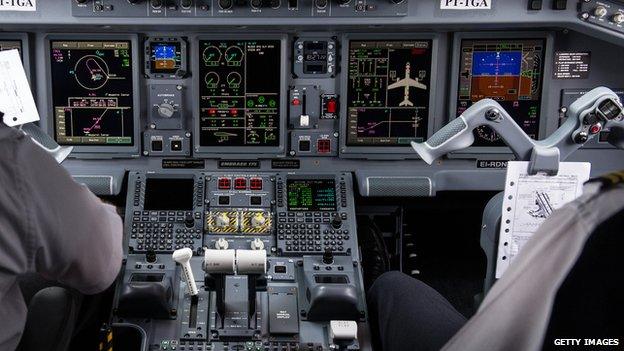How do amputees fly planes?
- Published

A pilot lost control of a passenger plane after his artificial arm became detached as he was coming in to land, an accident report has said. But how do amputees fly planes?
The pilot of the Flybe plane heading from Birmingham to Belfast had a below-elbow left arm prosthetic. This was attached to the yoke - the plane's "steering wheel" - using a clamp.
But, as he made the flare manoeuvre - a stage of the landing - "his prosthetic limb became detached from the yoke clamp, depriving him of control of the aircraft".
The UK's Civil Aviation Authority (CAA) says forearm amputees have the medical certification to be commercial pilots. When amputees first get their licence they must fly with a chief instructor to check they have complete control. All commercial plane pilots have medical checks every six months.
It's very uncommon for prosthetics to come loose during flights, says Mike Miller-Smith, from Aerobility, a charity that teaches disabled people to fly. Passengers should not be concerned, he says.
But Dan Collins, who used to fly passenger planes and still flies light aircraft, admits he is surprised to hear amputees are allowed commercial licences. "I wouldn't have thought that a pilot could get a class one medical. It is very rigorous testing, for example if you fail the colour blindness test your licence is restricted or not issued."
For single arm amputees, it is relatively straightforward to get a commercial licence. But it must be proved that a failure of the prosthesis - if it fell off the stump for example - would not result in loss of control of the aircraft. Amputees can, for instance, demonstrate that they are able to control the yoke with their remaining arm, as with the pilot of the Flybe plane.
Double arm amputees are also allowed to fly. Their prostheses must be inspected to the same standards as aircraft parts.
For leg amputees there are different rules, depending on the type of amputation. Single below-knee amputees can wear their prostheses to operate the foot-controlled rudder - which changes the direction of the plane - and brakes. Somebody with two below knee amputations will usually have an additional hand controller that operates the same functions as the pedals.
For single above-knee amputees, pilots use their remaining leg to operate the plane. A rubber strap is attached to the foot pedal and then around the leg and is controlled by moving the leg up and down - often called the "dancing" technique. For double above-knee amputees, the additional hand controls are again used.
And despite the surprise that the idea of amputee pilots may elicit, the authorities believe the current system guarantees safety.
Follow @BBCOuch, external on Twitter and on Facebook, external, and listen to our monthly talk show